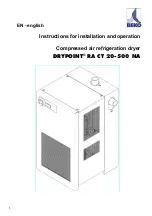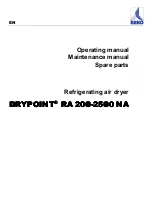
EN
3
dehumidifier TTK 165 ECO / TTK 170 ECO / TTK 380 ECO
•
Do not use the device in aggressive atmosphere.
•
Only put up the device in an upright, stable position on firm
ground.
•
Let the device dry out after a wet clean. Do not operate it
when wet.
•
Do not use the device with wet or damp hands.
•
Do not expose the device to directly squirting water.
•
Do not cover the device during operation.
•
Do not sit on the device.
•
This appliance is not a toy. Keep away from children and
animals. Do not leave the device unattended during
operation.
•
Check accessories and connection parts for possible
damage prior to every use of the device. Do not use any
defective devices or device parts.
•
Ensure that all electric cables outside of the device are
protected from damage (e.g. caused by animals). Never
use the device if electric cables or the power connection
are damaged!
•
The mains connection must correspond to the
specifications in the Technical annex.
•
Insert the mains plug into a properly fused mains socket.
•
Observe the device's power input, cable length and
intended use when selecting extensions to the power
cable. Completely unroll extension cables. Avoid electrical
overload.
•
Do not under any circumstances use the device if you
detect damages on the mains plug or power cable.
If the power cable is damaged, it must be replaced by the
manufacturer, its service agent or similarly qualified
persons in order to avoid a hazard.
Defective power cables pose a serious health risk!
•
Before carrying out maintenance, care or repair work on
the device, remove the mains plug from the mains socket.
Hold onto the mains plug while doing so.
•
Switch the device off and disconnect the power cable from
the mains socket when the device is not in use.
•
When positioning the device, observe the minimum
distances from walls and other objects as well as the
storage and operating conditions specified in the Technical
annex.
•
Make sure that the air inlet and outlet are not obstructed.
•
Make sure that the suction side is kept free of dirt and
loose objects.
•
Never insert any objects or limbs into the device.
•
Do not remove any safety signs, stickers or labels from the
device. Keep all safety signs, stickers and labels in legible
condition.
•
Only transport the device in an upright position with an
emptied condensation tank or drain hose.
•
Discharge the collected condensate before transport and
storage. Do not drink it. Health hazard!
•
Only use original spare parts, for otherwise safe and
functional operation cannot be ensured.
Safety warnings for devices containing flammable
refrigerants
•
Only position the device in rooms where potentially leaking
refrigerant cannot accumulate. Unventilated rooms, in
which the device is installed, operated or stored, must be
built in a way to ensure that potentially leaking refrigerant
cannot accumulate. This serves to avoid fire or explosion
hazards resulting from an ignition of the refrigerant by an
electric furnace, cooking stove or another ignition source.
•
Only position the device in rooms where there is no source
of ignition (e.g. open flames, an active gas appliance or an
electric heater).
•
Please note that the refrigerant is odourless.
•
Only install the device in compliance with the national
installation regulations.
•
Please observe the local regulations.
•
Observe the national gas regulations.
•
Only install, operate and store the device
TTK 165 ECO
/
TTK 170 ECO
in a room measuring more than 11 m
2
.
•
Only install, operate and store the device
TTK 380 ECO
in a
room measuring more than 14 m
2
.
•
Store the device in a way that no mechanical damage can
occur.
•
Please note that the connected pipelines must not contain
any sources of ignition.
•
R290 is a refrigerant that complies with European
environmental regulations. No part of the cooling circuit
may be perforated.
•
Observe the maximum refrigerant capacity in the technical
data.
•
Do not drill through or burn.
•
Do not use any means other than those recommended by
the manufacturer for accelerating the defrosting process.
•
Every person working with or at the refrigerant circuit must
be able to provide a certificate of qualification issued by a
body accredited by the industry, demonstrating their
competence in the safe use of refrigerants based on a
procedure well-known in the industry.
•
Service work may only be carried out in accordance with
the manufacturer's specifications. If maintenance and
repair work require the support of additional persons, the
person trained in handling flammable refrigerants shall
continuously supervise the work carried out.




































